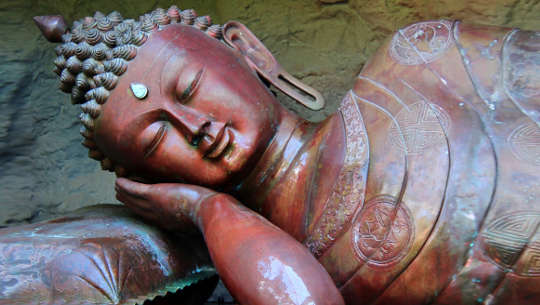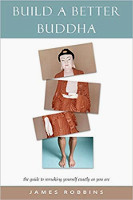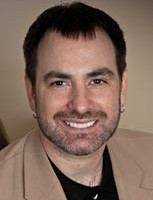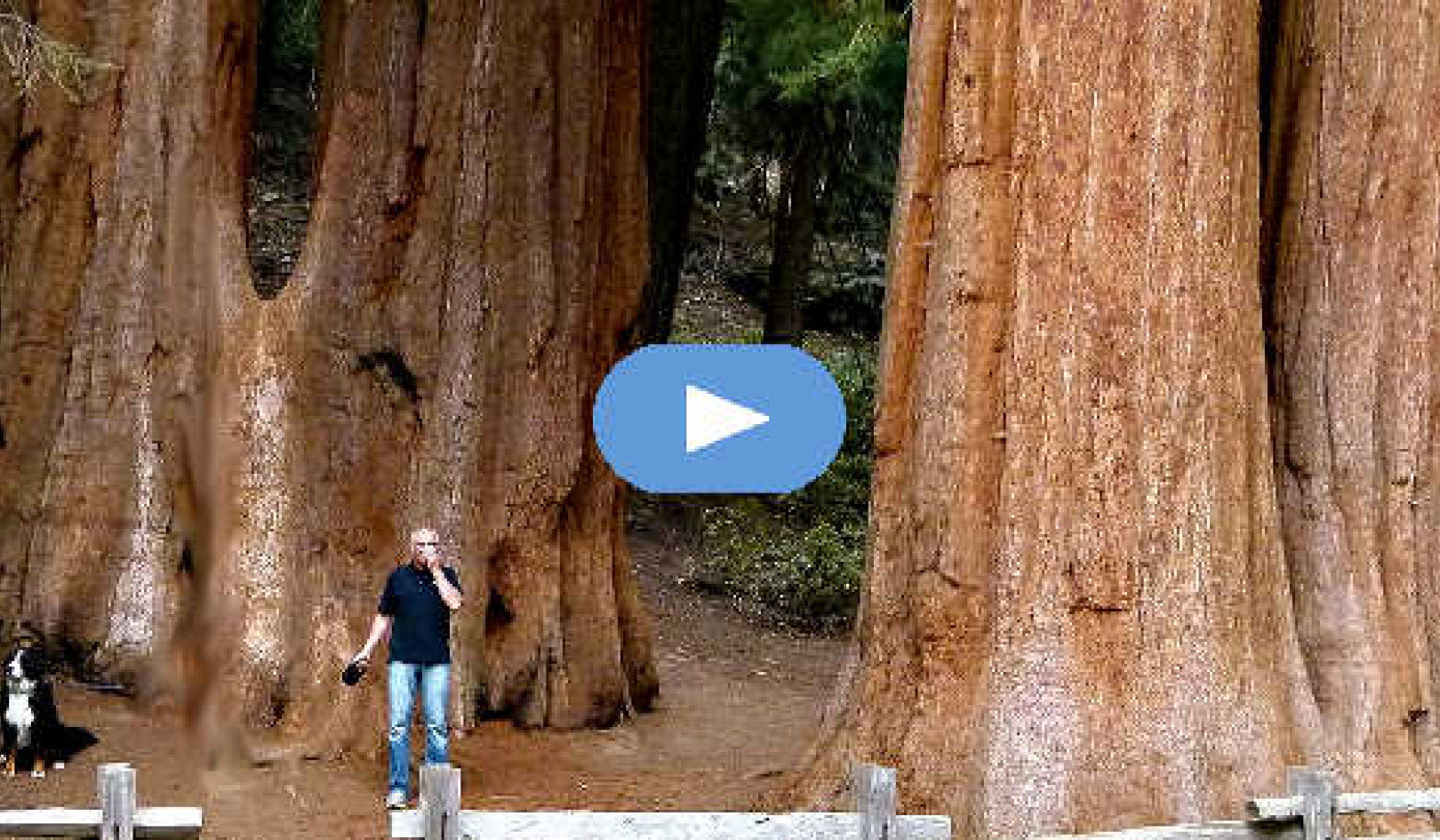
Image by Lolame
We are aware that we suffer from optical delusions, but we still suffer, nonetheless. We have more or less just shifted our dissatisfaction onto a new playing field, it might seem. Like Paul Simon sings,
"Breakdowns come
And breakdowns go
So what are you going to do about it?
That's what I'd like to know."
We can see that there has been a breakdown somewhere along the way, but by what practical means are we going to heal ourselves?
The answer to this all-important question -- the comically simple message which recurs, in one form or another, anywhere we look -- is summed up by Lao Tzu:
In the pursuit of learning, every day something is acquired.
In the pursuit of Tao, every day something is dropped.
Less and less is done
Until non-action is achieved.
When nothing is done, nothing is left undone.
The world is ruled by letting things take their course.
It cannot be ruled by interfering.
How are we going to build a better buddha for ourselves? Not by assembling, it would seem. According to Lao Tzu, we are going to build a better buddha by, well, not building. We are simply going to "let things take their course" -- what the Taoists call "non-action" or "work without doing." We will sit back, relax, and let the buddha do all the work -- let the buddha build the better buddha.
Rolling, Rolling, Rolling...
Imagine a bowling ball rolling down a hill. Once this process has been set in motion, there is nothing for you to do. The ball, the hill, and natural physical forces take care of the rest of the journey. The best you can do to help the ball along toward its destination is simply avoid interfering.
So it goes with the spiritual path. Each of us is already rolling down the hill just fine, already well on his or her way to perfect Christ consciousness or Buddha nature. Each of us has already received the necessary initial push the minute we started to wonder about God, death, morality, and the meaning of life.
Just as the bowling ball automatically gains momentum as it rolls further and further down the hill, you also gain momentum as you tumble along your own explorative path. From that perspective, trying to speed yourself along is no more useful than the bowling ball trying to speed itself along.
Different Strokes for Different Folks
In the same way the many spiritual paths differ in their relative emphasis on direct perception versus compassion, they also tend to take different approaches to individual effort.
The traditional Hindu path, for example, tends to encourage vigorous individual effort, which, over millions and millions of lifetimes, finally results in liberation. Zen, on the other hand, ultimately encourages the process of "sudden awakening," an event that sometimes occurs after a single unexpected word, or startling bamboo strike, from the Zen master. Properly understood, however, these are not two entirely different paths.
Let's go back to the metaphor of the bowling ball. The bowling ball receives a single push and it is on its way. The ensuing spontaneous, effortless journey down the hill may take moments or even days depending on the size and slope of the hill. Even so, the moment when the bowling ball finally reaches the bottom of the hill, it is suddenly there. In the same way, as individual seekers, we receive that initial push at various places along various paths.
At present, you may think you are making this and that effort -- and to the degree you need to think of it this way, this is true -- but you are actually just rolling along, having received some unplanned for push somewhere in the past. Even so, the day will inevitably come when you reach your destination and -- all of a sudden -- you realize you have been there the whole time.
A Vision Unfolds
My own path illustrates how this paradoxical course of effort/effortlessness can run. I grew up Christian. Being a rather anxious child, I tended to fixate on certain elements of the Christian faith that stress the need for constant effort and struggle, a kind of perpetual "work" on the seeker's part.
Entirely unfamiliar at this stage with the paradoxical idea of "work without doing," I instead internalized Apostle James' assertion that "faith without works is dead" (James 2:26). Whereas the Tao Te Ching encourages the "no fight: no blame" attitude toward spiritual evolution, Paul admonishes Timothy to "Fight the good fight" (1 Tim. 6:12). Throughout both the Old and New Testaments, in fact, military imagery pervades.
Although Taoism certainly isn't without its own military metaphors, its writings typically favor the image of a stream, an effortless flow that, like the bowling ball in the previous example, tumbles along without resisting the natural currents. Taoism, in fact, is often called the "Watercourse Way":
The highest good is like water.
Water gives life to the ten thousand things and does not strive.
It flows in places men reject and so is like the Tao.
This is not to suggest, of course, that all Christians necessarily get distracted by the unrelenting spiritual "fight." When viewed from the highest, broadest perspective, the teachings of Christ likewise encourage total peace and acceptance, both of oneself and of others.
My personal temperament, however, mingled with certain biblical teachings in such a way as to cultivate a rather workaholic approach to the spiritual path. Not surprisingly, then, despite my regular church attendance and earnest Bible study, I felt quite distant from God and all things sacred. I had a feeling that something holy was sort of "out there," but I certainly hadn't encountered it. There was a lot of work and military maneuvers going on, but very many things left undone.
Waiting for Something...
Due to this chronic spiritual dissatisfaction, I grew up in the Church with a feeling that I was waiting on something -- some kind of call from God. I remember being very affected by one story about the Old Testament prophet, Samuel. "In those days," the story starts, "the word of the Lord was rare; there were not many visions" (1 Sam. 3:1). This was a beginning I could relate to.
Despite my continued efforts, there were most certainly not many visions. Here enters Samuel, a boy who gets called by God in the middle of the night. Samuel goes on to do many great things because "The Lord was with Samuel as he grew up, and he let none of his words fall to the ground" (1 Sam. 3:19). So I would wake up every night, thinking maybe this was the night. I was ready to do something dramatic and holy, as long as it meant connecting with something genuinely sacred.
After much angst and metaphysical contemplation, I arrived, nonetheless, in late adolescence having never received the call. Frustrated and painfully disappointed, I gave up on all things spiritual, dismissing them as fearful superstition, and became a rather militant atheist. So how did I end up here, then, writing this book?
Experimenting with Meditation
We will need to backtrack a bit to when I was about ten or so. At this time, I'd happened -- through my martial arts study -- on some books about meditation. Having a general interest in all things metaphysical, I began to experiment with meditation a bit. I had no concept, however, of meditation as something people did for spiritual advancement. My church hadn't made the connection between prayer and meditation evident for me. I simply thought of it as a hobby, something I did out of curiosity.
Within the first week or two of experimenting with some very simple mindfulness meditations, I began to experience states of heightened mystical awareness -- states that, I came to discover years later, are well-documented in the Eastern traditions and are considered highly significant. My meditation books didn't mention anything like these experiences, nor did the Bible, so I lacked a solid context in which to understand what was going on. I found these experiences pleasant and interesting, but I didn't recognize them as hugely significant at that time.
I thought of these "visions" as being similar to what happens when you stare at a bright light too long. When you look away, the afterimage follows you wherever you look. In the same way, I intuitively understood, these colors and sounds I was experiencing in deep meditative states were a kind of perceptual foundation that was always there -- a kind of subtle, organizing grid lying beneath any experience I would encounter. When I saw this so-called grid in meditation, I was just seeing it more directly, looking straight into the framework of my own perception.
Etch-a-Sketching Your Mind
I remember playing with a toy called an Etch-a-Sketch as a kid. If you sketched away all the magnetic filaments, or whatever formed the drawing surface, you could see right down into the mechanics of the machine. This meditative experience was very much like that. I was using the process of my mind to sketch away all the other surface stuff so that I could look directly into my mind's mechanics.
These experiences began to occur at night, throughout the various sleeping and dreaming states. Sometimes, I would wake up out of a dream into these experiences, which were very relaxing and familiar somehow. In a way that is difficult to put into language, I realized these experiences represented the me that continued even when I lost my normal, waking consciousness. Such occurrences continued for a few months, gradually tapering off as I lost interest in formal meditation practice.
In my early 20s, however, in the middle of my roaring atheist phase, these experiences began again. This time they were entirely spontaneous. As in childhood, I was reading a bit of everything around this time, so soon thereafter, I inadvertently encountered descriptions of the mandala (Sanskrit for "magic circle") in the writings of the psychologist, Carl Jung. His account of the mandala as an archetype of the collective unconscious really resonated with me, as it seemed to perfectly describe my own mystical experiences. One thing led to another and, via Jung, I eventually discovered the writings of Eastern mysticism.
Nowhere To Go, Nothing To Do
After exploring a variety of Eastern spiritual systems including Buddhism, Hinduism, Taoism, and many others, I came across the Tibetans. I was amazed to find an incredibly detailed account in Tibetan literature describing the clear light experience. The literature spoke of the sound, rays, and light manifesting as one cohesive experience of flowing mandalas and so forth -- the exact phenomenon I had first witnessed as a child.
According to the Tibetans, such experiences, which can arise both in meditation and in sleeping states, were a kind of direct peek into the natural mind. The experience is typically illustrated as a cloudy sky clearing so that we can see the sun, which has been shining the whole time; which brings us to the moral of the story: the complete naturalness of the individual's relation to the whole, or One Self.
Although I do not currently identify myself within any one metaphysical system or practice, my present beliefs are perhaps best described through the teachings of Dzogchen, which is a form of Tibetan Buddhism. The Dzogchen "motto," much like the Taoist motto, is often expressed like this: "There is nothing to do. There is nowhere to go." This is in no way a negative or nihilistic statement, but simply an expression of profound peace and appreciation of the universe's innate wholeness.
The essence of Dzogchen is that of spontaneous self-perfection. The bowling ball is already rolling down the hill, says Dzogchen, so what else is there to do but sit back and watch as it reaches its ultimate, perfectly harmonious destination? Imagine a caterpillar gradually transforming into a butterfly. Does the caterpillar work to make this happen? Not exactly -- not unless you want to consider a caterpillar just being a caterpillar work.
Such is the paradoxical "method" of Dzogchen. If you simply be who you are, do what you do, then you are already well on the way to realizing your caterpillar self as a butterfly.
The Best Meditation is No Meditation
Dzogchen is already so close to us, it is said, that we tend to overlook it. The best meditation, according to Dzogchen, is no meditation. Here is where a lot of us are likely to get confused. Dzogchen, like Zen and Taoism -- and all other spiritual paths at their most genuine, esoteric core -- tends to be so elusive because it sounds too good to be true. The idea of "practice makes perfect" is so deeply ingrained in our collective psyches that we are very suspicious when someone comes along and says, "Hey! Guess what! Being makes perfect, not practice." It is amazingly simple.
Want to discover what your most effective "meditation" or "practice" is? You need only look to those things in your life that you already enjoy. Look to those things you do just because. You also have to look to those things we don't enjoy, look to those things we do because it seems like we have no other choice. Pleasant or unpleasant, desirable or undesirable, it's all living, all being. There is only one possible direction along the spiritual path, that is to say: onward, forever closer to total Christ consciousness or complete self-liberation.
We have all experienced what the Tibetans call the clear light time and again throughout our lives. It may not take the exotic form I'm describing, but the essence of the experience is the same. Ironically, such an experience of the natural mind is so natural that we tend to overlook it altogether. It might be as simple as sitting on the porch having a glass of lemonade, or taking the dog for a walk. The form it takes isn't nearly so important as the feeling, the essence of the experience. If we are looking for something "big," something strangely mystical, we are going to overlook those perfectly small, quiet moments in which we experience Zen's effortless no mind.
As long as the Dzogchen approach to self-realization sounds too good to be true, it probably is -- for you. Maybe you are still busy "improving" yourself. That's one of the darkest clouds in the sky of authentic self-perception to be sure, so take your time. The various paths of spontaneous perfection aren't going anywhere. For the time being, you have simply yet to realize a caterpillar, just as it is, is already just as good as a butterfly. Since this state of non-acceptance of caterpillar-ness describes the vast majority of us, I will later outline some specific means of self-improvement. Ironically, as you commit more and more energy to your practices of meditation and dream yoga, etc., they begin to "undo" themselves, somehow replacing effort with non-effort, or acceptance.
There are no accidents along the spiritual journey, you begin to realize, no tangents or distractions, only one experience of the True Self after another. As you reach this point, the point where you actually begin to enjoy being a caterpillar, suddenly you're popping out of your cocoon, unfolding your beautiful new wings.
The Cosmic Dance
At this point, I think it is fair to ask an obvious question: If you are already perfect, if you are already heading full steam down the path of spontaneous self-perfection, why are you reading this book? For that matter, why am I writing it? Alan Watts considers this same dilemma when he writes: "People appear to be under the fixed impression that one speaks or writes of these things in order to improve them or do them some good, assuming, too, that the speaker has himself been improved and is able to speak with authority."
For the record, let me just make it clear: I am not out to "improve" anyone, myself included. I have got a dance to do, you see, so I do it. This is what the Hindus call karma yoga. Your dance, which is no better or worse, no higher or lower, than my own, seems to involve reading this book just now. We have got a dance to do together, that is, so here we go -- round and round until we are dizzy. In The World's Religions, Huston Smith describes this Cosmic Dance beautifully:
If we ask why Reality, which is in fact one and perfect, is seen by us as many and marred; why the soul, which is really united with God throughout, sees itself as sundered; why the rope appears to be a snake -- if we ask these questions we are up against the question that has no answer, any more than the comparable Christian question of why God created the world has an answer. The best we can say is that the world is Lila, God's play. Children playing hide and seek assume various roles that have no validity outside the game. They place themselves in jeopardy and in conditions from which they must escape. Why do they do so when in a twinkling they could free themselves by simply stepping out of the game? The only answer is that the game is its own point and reward. It is fun in itself, a spontaneous overflow of creative, imaginative energy. So too in some mysterious way it must be with the world. Like a child playing alone, God is the Cosmic Dancer, whose routine is all creatures and all worlds. From the tireless stream of God's energy the cosmos flows in endless, graceful reenactement.
This dance doesn't mean anything, that is to say. We dance for the sake of the dance alone. As Shakespeare wrote about life in Macbeth, "it is a tale told by an idiot, full of sound and fury, signifying nothing." Put in the right context, this is far from a gloomy statement. If life "signified" something, someone would require us to write a book report at the end, right? We would have to tease out the moral or the message from its drama if we were to pass the final exam.
As it is, life is non-sense -- there is no final exam! Still, there is so much in it, so much sound and fury, like a beautiful Beethoven Sonata or a ridiculous Beatles song, this bizarre dance of life means nothing in particular -- nothing other than, well, a Beethoven Sonata or a Beatles song -- which is no small thing to mean.
To summarize everything we have examined so far, to succinctly address any questions that might have so far arisen,, I would like to offer a wise chunk of non-sense told by a fellow "idiot," Chuang Tzu:
Now I want to say a few words. Whether they are the right or wrong kind of words, they are at least some kind of words, and are no different than the words of others, so they're just okay. But please permit me to say them. There is a beginning. And there is a not-yet-beginning-to-be-a-beginning. There is a not-yet-beginning-to-be-a-not-yet-beginning-to-be-a-beginning. There is being. There is not beginning to be being. There is not yet beginning to be not yet beginning to be being. Oh, suddenly there's being and not being. Now I just had my say. But I don't know whether my saying has said anything or nothing...
To use a finger to make the point that a finger is not a finger is not as good as using a nonfinger to make the same point. To use a horse to prove that a horse is not a horse is not as good as to use a nonhorse to prove that a horse is not a horse. Heaven-and-earth is one finger. All ten thousand things are one horse. Okay? Not okay. Okay? Okay.
Huh?
Exactly.
It's like the story where the philosophy professor puts up the single question of the class final on the blackboard. As it turns out, that question consists of just one character: a question mark. One student turns his test in a few seconds later -- the only student who ends up making an A on the final.
His equally elegant answer: an exclamation point. That's the whole crazy dance, nicely summed up -- Question? Exclamation! How do you get that damned goose out of the bottle? I don't know, but it's out!
Reprinted with permission of the publisher
Nicholas-Hays, Inc. ©2003. www.nicolashays.com
Article Source
Build A Better Buddha: The Guide to Remaking Yourself Exactly As You Are
by James Robbins.
 These days, the search for self-actualization and liberation can be rather overwhelming. With so many spiritual systems and teachings readily available, many of us feel confused and intimidated. We want to find just the right system or teacher--but how? In this book, James Robbins guides you beyond the seeming complexities and idiosyncrasies of various beliefs and traditions, redirecting you toward a few, simple truths common to all paths of realization. In doing so, Robbins helps you recognize and distill the core teachings of both traditional and non-traditional paths into your own unique way. With this book you learn that you already have everything you need to expand your conscious awareness, recognize where you are on your path, and fully experience the profound beauty of life and the world we live in--right here, right now.
These days, the search for self-actualization and liberation can be rather overwhelming. With so many spiritual systems and teachings readily available, many of us feel confused and intimidated. We want to find just the right system or teacher--but how? In this book, James Robbins guides you beyond the seeming complexities and idiosyncrasies of various beliefs and traditions, redirecting you toward a few, simple truths common to all paths of realization. In doing so, Robbins helps you recognize and distill the core teachings of both traditional and non-traditional paths into your own unique way. With this book you learn that you already have everything you need to expand your conscious awareness, recognize where you are on your path, and fully experience the profound beauty of life and the world we live in--right here, right now.
About the Author
 JAMES ROBBINS -- along with his wife, clinical psychologist Dr. Heather Robbins -- co-founded Dallas Mindfulness Practice, an organization that offers instruction within several traditional meditative paths and Eastern wisdom traditions.
JAMES ROBBINS -- along with his wife, clinical psychologist Dr. Heather Robbins -- co-founded Dallas Mindfulness Practice, an organization that offers instruction within several traditional meditative paths and Eastern wisdom traditions.
Readers can contact James or learn more about a variety of spiritual topics through his Web site www.dallasmindfulness.com and https://dallaswholelife.com/


























